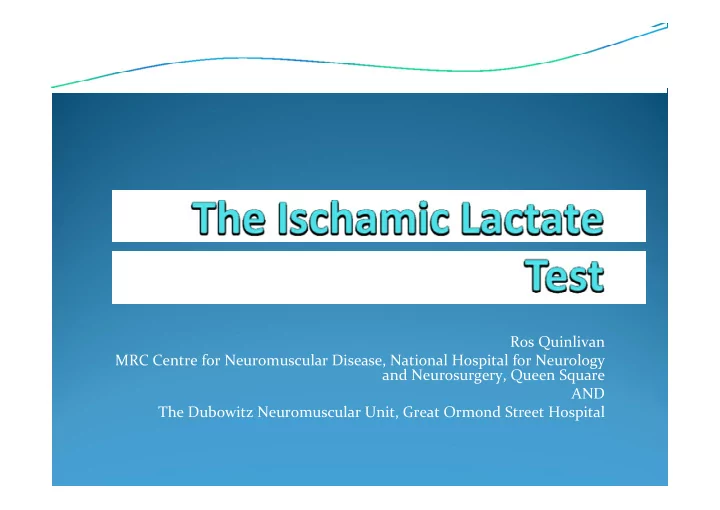

Ros Quinlivan MRC Centre for Neuromuscular Disease, National Hospital for Neurology and Neurosurgery, Queen Square AND The Dubowitz Neuromuscular Unit, Great Ormond Street Hospital
McArdle Disease GSDV — Incidence 1:100,000 — Autosomal recessive mutations in PYGM — Absent or severely reduced muscle phosphorylase — Failure to produce lactate during ischaemic exercise
Features N=59 % Exercise Related Pain/ Fatigue 59 100 Second wind 51 86 Myoglobinuria 36 61 Renal Failure 6 10 Hyperuricaemia 8 13 Muscle Hypertrophy 24 41 Muscle wasting 16 27 Paraspinal, shoulder, Peri-scapular Muscle weakness MRC 4 12 20 Shoulder girdle Axial
Age yrs <10 10-19 20-29 30-39 40-49 >50 Age at 54 6 0 2 0 onset of 87% 9.6% 3.2% symptoms n=65 Age at 6 11 12 12 13 7 diagnosis 10% 18.3% 20% 20% 21.6% 11.6% N=60 96% onset <20 years 28% diagnosed <20 years
Differential Diagnosis — Other glycolytic disorders — Muscular Dystrophies — Fatty acid oxidation defects — Mitochondrial disorders
Investigations — Creatine kinase — Average 2,700 iu/l (range 230-13,000) — Muscle biopsy
Muscle biopsy: caution — Phosphorylase is unstable and fades quickley — Regenerating muscle expresses the foetal isoenzyme — Glycogen depletion (critical illness) phosphorylase histochemistry will not work — 18% of patients previously diagnosed by muscle biopsy did NOT have McArdle disease
Ischaemic Lactate test: Equipment — Cannula — Sphygmomanometer cuff and bulb — 8 Fluoride oxalate tubes (lactate) — 8 EDTA tubes for (ammonia) — Ice — Fasting patient
Protocol — Baseline Blood sample — Lactate — ammonia — Inflate Sphygmomanometer cuff >systolic BP — Patient rapidly grips repetitively for 1 minute (some protocols say 2 minutes) — After two minutes, when patient fatigues cuff is deflated — Blood is taken at 1, 2, 3, 5, 7, 10 and 12 minutes — Lactate — Ammonia — Blood samples must be kept in ice
Normal result: 3-5 fold increase in lactate and ammonia A failure for both Lactate and Ammonia to rise indicates a failed test
Problems with the test — Protocol not standardised — Healthy individuals can’t exercise for more than a minute — GSD V patients often can’t exercise for a minute — False results — Ipsilateral ante-cubital vein not used — Blood taken before cuff is deflated — If ammonia not simultaneously measured — Samples not put in ice — Potential adverse events — Severe cramping/ discomfort — Myoglobinuria — Compartment syndrome
Non-ischaemic forearm exercise test Hogrel et al Neurology 2001 — 26 healthy controls and 32 patients with a metabolic myopathy — Aerobic forearm exercise at 70% maximum voluntary contraction for 30 seconds — Discriminates GSDV from normal
Kasemi-Esfarjarni et al Ann Neurology 2002 — 9 GSDV patients and 1 phosphoglycerate mutase deficiency — Identical protocol to ischaemic forearm test without ischaemia — Similar results with both protocols — No cramps with non-ischaemic test — Four patients could not complete ischaemic forearm test
Diagnostic cycle test Vissing and Haller 2003 — 24 GSD V — 17 normal controls — 25 other metabolic myopathies — Cycled at constant workload — for 15 minutes Heart rate and respiratory gas exchange measured — Second wind 7-15 minutes in McArdle subject
12 minute shuttle test — Patient walks as far as possible in 12 minutes — Borg RPP must not exceed 4 — Every one minute record — Heart rate — RPP — Distance travelled (walking speed)
12 minute walk test Quinlivan et al JNNP 2010 — 36 patients studied on more than one occasion for baseline assessment — Second wind identified in 100% — For some it was the first time — Pain and heart rate increase at 2-3 minutes — Pain and Heart rate ratio peak at 5 – 6 minutes — Second wind at 6-8 minutes
12 minute walking assessment Minutes Heart Rate Walkin RPP g speed km/hr 1 90 4.0 0 2 117 5.5 0.5 3 140 5.5 5.0 4 144 4.5 3.0 5 142 4.5 3.0 6 152 4.5 3.0 7 143 4.5 3.0 8 134 4.5 2.0 9 116 4.5 2.0 10 122 5.5 2.0 11 131 5.5 2.0 12 133 5.5 2.0
Rating of Pain as a ratio to walking speed Group Mean (n = 20) (John Buckley) Ratio of perceived pain to walking speed (log transform) -2.5 B -3.0 -3.5 -4.0 -4.5 -5.0 1 2 3 4 5 6 7 8 9 10 11 12 Minutes
DNA analysis R50X/ R50X/ R50X/ G205s/ Other G205s R50X other G205s 41/75 9/75 2/75 4/75 21/75 c2430C> T,G810G Pakistani male: C2386_2387delG Homozygous c1129A> T,N377Y exon 1 c.14delT c808C> T, R270X c1345G> A,G449R Caucasian female: c2465C> A,G133R Compound c2465C> A,A822D Heterozygote c403G> A,A822D c403G> A,Gi33R 1x L36p/ c279C> T,R94W c1239A+ 1G> A c1466C> G, P489R c107T> C, L36P Pakistani Sibs Arg576x/Arg576x 3xPro489Arg 54.6% 28% 12% 2.6% 5.3% R50X, G205S 70% diagnostic, 95% at least one allele mutated
Summary — Forearm exercise test is not essential for the diagnosis of McArdle disease — Ischaemia is not necessary — Protocol must be standardised open to error — The test should not be performed by inexperienced individuals without supervision — Useful test normal result excludes glycolytic disorder — Other forms of exercise testing may be more useful for patients with suspected McArdle disease
Acknowledgements — John Buckley, Chester University — Association for Glycogen Storage Disorders
Recommend
More recommend